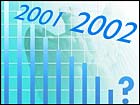|
Fed officials cautious
|
 |
January 8, 2002: 3:06 p.m. ET
A number of central bank officials say pace of recovery unclear.
|
NEW YORK (CNN/Money) - Federal Reserve Board officials spoke out about the state of the U.S. economy Tuesday, giving no real clues about the future of monetary policy, but hinting that they did not expect a particularly robust recovery in 2002.
The Fed, the central bank for the United States, cut its target for short-term interest rates 11 times in 2001 to keep consumers spending despite a recession, rising unemployment, and the Sept. 11 terror attacks.
Recent economic data have indicated a recovery could be near, and many economists think the Fed will start raising rates again in 2002 to temper growth and fight inflation.
But recent comments by Fed officials - including members of the central bank's policy setting committee - indicate the Fed may not be so optimistic about the state of the economy that it will be raising rates again any time soon.
Philadelphia Fed President Anthony Santomero, a voting member of the policy committee, said Tuesday he expected the Fed's rate cuts, together with government spending and tax cuts in 2001, to pave the way to a recovery by the middle of 2002.
But he also pointed to several roadblocks to a speedy recovery, including a glut of unsold inventories, unused technology and factory equipment - the residue of the spending boom of the late 1990s - along with rising unemployment and a weak global economy.
"In short, a number of sectors will need to transition before we can be confident of an acceptable level of economic activity," Santomero said in a speech delivered to the Philadelphia Chamber of Commerce.
"In the near term, we will be watching indicators like holiday retail sales, employment, consumer confidence, new orders in the manufacturing sector, foreign growth estimates and business inventory levels to see that recovery is on track," he added.
Implied yields on federal funds futures contracts - often accurate predictors of what the Fed will do with rates - anticipate the Fed will leave its target for the federal funds rate unchanged at 1.75 percent at its Jan. 29-30 policy meeting and could add half a percentage point to that target by August.1
If the recovery is sluggish, on the other hand, then the Fed will be less likely to raise rates again in 2002.
"Santomero's comments are consistent with the notion that there's great caution [among Fed policy makers]," said Anthony Chan, chief economist at Banc One Investment Advisors. "The economy's coming back, but not all that rapidly."
"More rate cuts may not be forthcoming, but the Fed is also not likely to start raising rates as quickly as financial markets expect," Chan added.
Click here for more on the Fed and rates
Sounding even more cautious than Santomero, Atlanta Fed President Jack Guynn, who is not a voting policy committee member, told the Rotary Club of Atlanta on Monday that a recovery could take another six months and that gross domestic product (GDP) could shrink "for another quarter or two" after possibly showing no growth in 2001.
U.S. GDP shrank in the third quarter of 2001 and may have shrunk again in the fourth quarter, matching the common definition of a recession. Most economists also recognize the definition of the National Bureau of Economic Research, which declared a recession actually began in March.
Following a speech Tuesday, New York Fed President William McDonough, the Fed's Vice Chairman and a voting policy committee member, told Reuters the recession may be shallower than most U.S. recessions, but the pace of recovery was unclear.
"There are data saying that the economy is starting to recover, and there are data saying that it tends to be weak," McDonough was quoted as saying.
Most economists, citing the resilience of consumer spending and confidence despite a lingering slump in business spending, think the economy will stabilize in the first quarter of 2002 and return to growth in the second quarter.
Richmond Fed President J. Alfred Broaddus Jr., in a speech Tuesday at Virginia Commonwealth University, said the consensus scenario for recovery seems the most likely. But Broaddus, who is not a policy committee member, also echoed Santomero's caution about the recovery's pace.
"I think there's a good chance that the economy may be at least a little softer than the consensus over the next year or so," Broaddus said. "In either case, we'd see a more gradual recovery from the recession than in most other postwar business cycles." 
|
|
|
|
|
|

|

